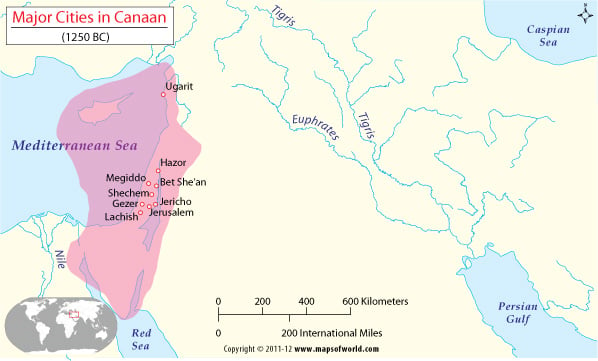Origins of the Canaan civilization center on the regions currently forming part of Palestine. Historians and theologists believe that Canaan is the Promised Land of the Israelites referred to in the Old Testament. The book of Genesis refers to the Canaanites as descendents of Canaan, the son of Ham. Ham was the son of Noah who restored life after the Great Flood.
References to the land of Canaan are also found in ancient Egyptian, Phoenician, and Syrian texts. In most of these, the land of Canaan seems to encompass parts of Syria, Jordan, and Israel, in addition to Palestine. The name Canaan is believed to have been derived from the Semitic word for purple. This could be a reference to the purple dye found aplenty in Palestine.
History of Canaan
Evidence of human life and agricultural activity is found on the coasts of Canaan as far back as 8000 BC. Excavations in Jericho, located near the Jordan River, have revealed the existence of over twenty successive settlements belonging to the Canaan civilization. From 7000 BC through 4000 BC, Canaan was the home to a civilization adept in building structured settlements. By the advent of the Chalcolithic Age, Canaanites had perfected pottery, masonry, and bronze metal works.
Through the third and second millennia, Canaan faced many invasions. The Amorites came from the northeastern frontiers; the Hyksos, the Hurrians, and the Egyptians invaded and settled in Canaan. Canaanite culture was heavily influenced by Egypt in the second millennium BC.
By about 1250 BC, the Israelites gained dominance over Canaan. The Philistines, who invaded Canaan in around 1150 BC, came into conflict with the Israelites. The emergence of King David in the tenth century BC was a significant factor in the Israelite emergence and in the final subjugation of the indigenous Canaanites. Thereafter Canaan came to be known as Israel.
Sources of Canaan studies
Most of our knowledge of Canaan is derived from Phoenician, Cretan, Hurrian, Babylonian, and Egyptian literature. The Ras Shamra tablets and the Amarna Letters reveal much about the civilization, culture, and location of Canaan. Important excavations have been undertaken in Jerusalem, Bet She’an, Hazor, Lachish, and Shechem, bringing to light the political, social, and economic conditions of the times.
Canaanite Religion
The discovery of the Ras Shamra tablets in 1928 brought to light much of what is known about the Canaanite religion. Like most pagan religions, the Canaanite religion idolized forces of nature. El and Baal were the main deities. El was the lord of rainfall and Baal caused the earth to be fertile. Other major deities of the Canaanite religion were Kothar, Asherah, Resheph, and Astarte.
Early Alphabet
The use of the alphabet was pioneered by the Canaanites. The language of Canaan was the earliest form of Hebrew. While the use of Phoenician and cuneiform was not unknown in ancient Canaan, the Canaanites are known to have devised their own form of writing which later evolved into Hebrew.

 Mongol Empire
Mongol Empire